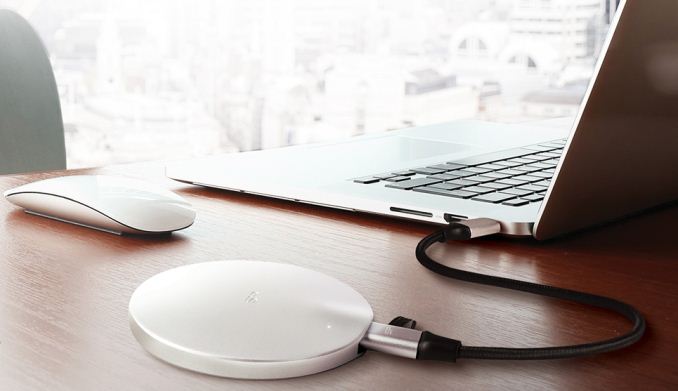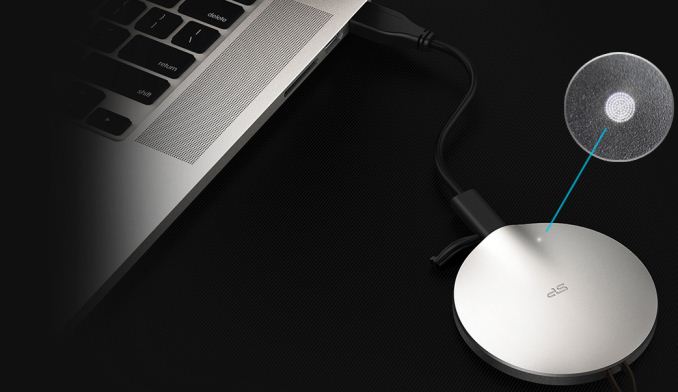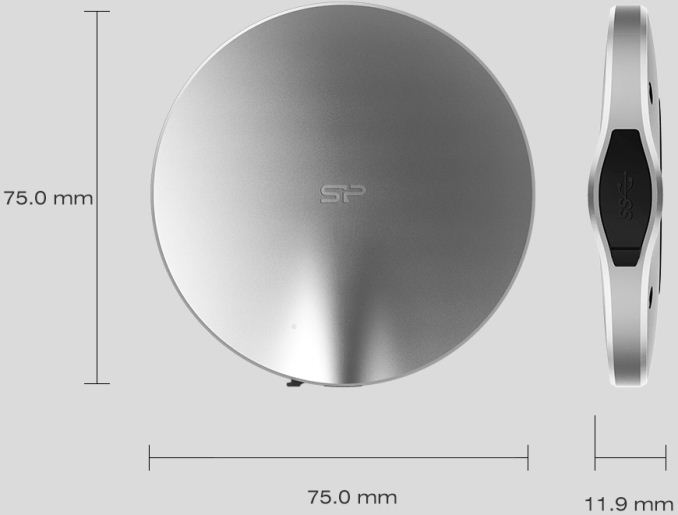Silicon Power Launches Bolt B80 External SSD: 500 MB/s, IP68, USB-C Interface
by Anton Shilov on October 13, 2017 1:00 PM EST- Posted in
- SSDs
- Storage
- Silicon Power
- IP68
- Bolt B80

Silicon Power has announced its new lineup of stylish external SSDs. The SP Bolt B80 family of drives comes in a rugged UFO-shaped chassis, which is IP68 dust and waterproof. When it comes to performance, the Bolt B80 resembles other external SSDs that offer read speeds of up to 500 MB/s. The new unit also uses a USB Type-C input to make it easier to connect to the latest laptops.
The Silicon Power Bolt B80 family of external SSDs includes models with 120 GB, 240 GB and 480 GB capacities. The manufacturer does not disclose what kind of NAND flash memory is uses, nor the controller it for the drive, but only publishes maximum sequential read and sequential write speeds of the product: 500 MB/s and 450 MB/s, respectively. Such levels of performance indicate that we are likely dealing with an entry-level SSD packed inside the Bolt B80, but a good news is that the drive reserves a lot of NAND flash for overprovisioning to ensure durability and reliability.
Apart from performance, chassis design is another important selling point of the Silicon Power Bolt B80 family. The drives are made of machined aluminum and feature a flying saucer shape. The enclosure is rugged enough to withstand a 1.22-meter military free fall test (MIL-STD-810G 516.7 Procedure IV) and is IP68 water and dustproof. Despite being sealed, the Bolt B80 has a LED indicator covered with microporous laser-cut aluminum that allows the light to shine through, but keeps the water out. As for weight and dimensions, the SP Bolt B80 is 75 mm in diameter, 11.9 mm thick, and weighs 53 grams.
| Silicon Power Bolt B80 Specifications | ||||
| 120 GB | 240 GB | 480 GB | ||
| Speed | Read | Up to 500 MB/s | ||
| Write | Up to 450 MB/s | |||
| Interface | USB 3.1 Gen 2, Compatible with USB 3.0, USB 2.0 |
|||
| Cable | USB-C-to-USB-A | |||
| Dimensions | 75 × 75 × 11.9 mm 2.95 × 2.95 × 0.46 inches |
|||
| Model Number | SP120GBPSDB80SCS | SP240GBPSDB80SCS | SP480GBPSDB80SCS | |
When it comes to external interface, Silicon Power says that the drive uses USB 3.1 Gen 2 (without disclosing the actual controller) with a USB Type-C connector, but it is also backward compatible with USB 3.0 and USB 2.0. In fact, the Bolt B80 is supplied with a braided USB-C-to-USB-A cable to connect the unit to PCs. The choice of connectors looks rather logical: the USB Type-C port might be easier to route inside a tiny device and easier to protect against liquids (granted, there are waterproof USB-C ports available), whereas the USB Type-A is the most widespread connector in the world. Meanwhile, modern notebooks that only have USB-C connectors ship with appropriate USB-C-to-USB-C cables, but unfortunately such cables are usually USB 2.0-only (at least, MacBook Pros are shipped with such cables) meaning that their owners are going to miss Bolt B80’s SSD performance unless they get a proper cable or a USB-A-to-USB-C adapter (which might feel a bit odd).
Silicon Power’s Bolt B80 external SSDs are covered by a three-year limited warranty and will likely hit the market in the coming weeks. The manufacturer did not touch upon their MSRPs in its press release, but typically Silicon Power’s products are priced competitively against the rivals.
Related Reading
Source: Silicon Power













12 Comments
View All Comments
thetuna - Friday, October 13, 2017 - link
53 grams? Is that correct?GTRagnarok - Friday, October 13, 2017 - link
Yes. It's pretty small. Only 3 inches in diameter.austinsguitar - Friday, October 13, 2017 - link
what a nice looking wireless char.... oh wait its a external ssd.... NEXT :^)danjw - Friday, October 13, 2017 - link
Here is a USB 3.0 capable cable: https://www.startech.com/Cables/usb-c/usb-c-usb-3-...jeffbui - Sunday, October 15, 2017 - link
Might as well get this one since it does it all: USB3.1 gen 2, Thunderbolt 3, and USB-PD 100w - https://www.amazon.com/Belkin-USB-IF-Certified-Thu...vailr - Friday, October 13, 2017 - link
They ought to include a USB Type C to USB Type C cable; one rated at the fastest transfer rate of 10Gb/second. Should be able to be bootable as an external "Win to Go" installation of Windows and/or of macOS, either connected to USB 3.0 port or USB Type C port.nerd1 - Sunday, October 15, 2017 - link
Plain stupid form factor... and what's the point of using USB-C with SATA3 bottleneck?thesandbenders - Sunday, October 15, 2017 - link
nerd1: Agreed, SATA on USB3 seems useless at first but a lot of newer laptops only have 1 USB 3.0/3.1 port and 1 USB 2.0 port. If start hanging multiple devices off the USB 2.0 port, the overall bandwidth of 2.0 can become a problem.name99 - Sunday, October 15, 2017 - link
Pop some eInk on the top, make it display an analog clock, now you've got a flash drive that's a "work of art":-)
Damn, I should be in marketing.
b1gtuna - Monday, October 16, 2017 - link
This or Samsung's T5?